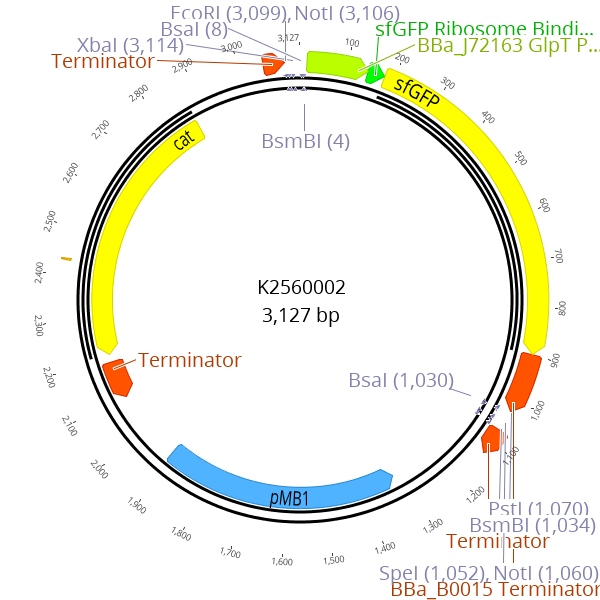There is always space for improvement, no matter how long you've been in the business.
-- Oscar de la Hoya
Cloning is the daily bread of molecular biologists. Almost all synbio projects start with weeks or months of cloning, a time which is the most frustrating and simultaneously least rewarding period of a project. Being able to distinguish between the native vector and the successfully assembled plasmid clearly while picking can save a lot of time and work. During the last decades, many approaches have been established to help distinguishing between false and correctly assembled plasmids. In our project, we created the Marburg Collection, a novel golden-gate-based cloning toolbox. This toolbox consists of LVL0 parts stored in a
pSB1C3
derivat.
As many plasmids had to be created, we desperately needed a simple, fast and cheap way to reliably select correct colonies even for inefficient clonings.
Here, we present the improvement of an iGEM-part for (a mostly faster,) easier and cheaper selection which suits our needs.
iGEM provides the universal acceptor plasmid
BBa_P10500
for creating new PhytoBricks. This plasmid contained the lacZ-α part in the cloning sites for blue-white screening. The lacZ-gene encodes the β-galactosidase, which catalyzes the hydrolysis of the glycosidic bond of β-galactopyranosides like D-lactose. Blue-white screening is based on alpha-complementation, where the α- subunit (C-terminal section) and ω-subunit (N-terminal section) of the β-galactosidase (both non-functional peptides) are able to reconstitute a functional enzyme. By the addition of the two D-lactose Analogues Xgal (5-bromo-4-chloro-3-indolyl-β-D-galactopyranoside) and IPTG (Isopropyl ß-D-1-thiogalactopyranoside) to the plates, colonies with successful cloning products thereby no lacZ-α will have the typical white colour while the unsuccessful ones precipitate the blue-coloured product resulting in blue colonies.
For further reading, click here.
However, this kind of selection requires the use of specific strains which possess the lacZ-ω but neither the native lacZ nor the lacZ-α fragment. As an example, the
E. coli NEB Turbo
strain which is routinely used for cloning harbors a lacZ without the N-terminal portion. As we wanted to establish Vibrio natriegens as a chassis for cloning, we investigated if the wild type strain is compatible with blue-white screening. Unfortunately, cloning using
BBa_P10500
in V. natriegens shows no difference between colonies containing the lacZ-α dropout and those without. For further reading about the lac operon of V. natriegens, click here.
To overcome this limitation and to enable fast and reliable cloning with V. natriegens, we decided to establish a new visualization method. Our improved part, namely
BBa_K2560002, is a derivative of the iGEM
BBa_P10500
containing a
sfGFP
dropout as fluorescent selection marker.

Our improved part BBa_K2560002 is a derivate of the BBa_P10500 containing sfGFP drop out.

A: Colonies of wild type, B: white colonies containing BBa_P10500 and C: colonies with BBa_K2560002 resulting in green colonies.

A: Colonies of wild type, B: blue colonies containing BBa_P10500 and C: colonies with BBa_K2560002 resulting in green colonies.
By using our improved part for cloning, the detection of successfully ligated clones from non is feasible for strains which are not compatible with blue-white screening and therefor becomes more universal, faster and cheaper than before.

